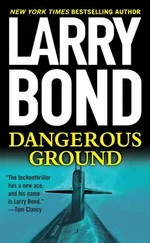“Slow to three knots.” Petrov’s order was echoed by the deck officer and the watch section engineer. It went against his grain to slow the boat, but it was necessary. As they ascended, they’d start bumping into ice floes on the surface. Severodvinsk’s sail was strengthened, but she wasn’t an icebreaker.
“Deck Officer, make your depth twenty meters.”
Once the top of her sail was close to the surface, they could receive the very-low-frequency transmission through the sail-mounted antenna assembly. Designed for use by submarines under the Arctic ice pack, where raising an antenna was not always possible, this specially designed system used four flat antennas that were flush with the top of the sail.
They’d have to come shallower than twenty meters to get a good signal, but Petrov wanted to make sure there was no one up there first, by raising a periscope and having a look around. He wasn’t too worried about exposing his position. These were Russian waters. Any aircraft overhead would have a red star on the side, and with the ice, it was unlikely there were any surface vessels.
But prudence demanded he know for certain. And then there was always the possibility of a large and virtually silent iceberg. He’d see one of these frozen monsters long before they could detect it with their collision-avoidance sonar. Mikhail Shubin, the deck officer, announced “Twenty-five meters,” and Petrov moved to the periscope. When Shubin announced, “Twenty-two meters, leveling off,” Petrov ordered “Up periscope” almost before Shubin finished his report.
Petrov held his face against the eyepiece and rode the scope up. At twenty meters, the optics barely cleared the surface. The idea was to expose as little of the scope as possible. In a calm sea, a few centimeters above the water was plenty. Waves made it harder. Today there were large swells and it was still raining.
He quickly turned the scope in a circle, first searching on the horizon and the surface of the water, then a second rotation to search above the horizon. The periscope was extended to its full height, and with most of the barrel still underwater the rocking of the boat didn’t make it easy to finish the safety search quickly. Long practice had taught him how to make a fast scan.
As Petrov ordered “Down periscope!” Kalinin checked his watch and said, “Thirty-two seconds.”
The captain reported, “No contacts. Make your depth sixteen meters.” He frowned, an artist rating his latest performance. “That was too long, I had to slow down because of the chop. There must be a gale blowing. There are good-sized waves up there, in spite of the ice.”
The periscope image was recorded on a hard drive and then displayed on a TV monitor in the central post. Kalinin and Petrov reviewed it together, looking for any contacts that might have been missed on the first quick viewing — all standard procedure.
Although a color image, it was nothing but grays, with a dark mottled sky and darker gray water that occasionally lapped over and smeared the periscope lens. This close to the edge of the ice pack, the ice floes were different shapes and sizes, dancing on the waves as they were tossed about by the wind. Under a clear sky, Petrov had seen them splashed with blues and greens. Now they were dirty, almost greasy, uneven lumps.
He’d been born in the north, and he’d served in the Northern Fleet his entire career, but that only allowed him to cope with the environment better than men from the south. No amount of acclimatization would allow a wise man to become complacent when out on the Barents Sea. It was still a cold and hostile place.
“We’re receiving the message.” Mitrov’s voice on the intercom sounded almost triumphant. Communications officers lived for such times. A few moments later, the intercom announced, “Message complete. Decoding.”
Petrov ordered Kalinin, “Get us back down to one hundred meters, but stay at three knots. I’ll be in my cabin. Join me there once we’re at depth.”
He’d barely reached his cabin before the communications commander knocked and almost broke the door down. Mitrov thrust the page at him. “Contact report, sir.”
DTG: 0735 04/10/2008
TO: PLA Severodvinsk, K-329
FROM: Operations Directorate. Northern Fleet Headquarters
Amga warning buoy 11 reports acoustic contact on 04/10/08 from 0231–0240 hours local, probable Western submarine. Location 70° 40’ 15” North Latitude, 046° 48’ 50” East Longitude. Contact moving northeasterly at slow speed. Locate, identify, and report. Trail and disrupt operations if possible. More contact information to follow as obtained.
Petrov looked at his watch as he bolted from his cabin. Mitrov scrambled out of the way. It was 0747. Fleet headquarters had just told him the location of a Western submarine as of five hours ago. He spotted Kalinin en route to his cabin. The starpom saw his captain at the same time, got out of the way, and then fell in behind Petrov.
“We’ve got one, Vasiliy! Those damn things actually work!”
“The warning buoys?”
“Yes!” replied Petrov excitedly as he shot up the ladder.
Seconds later, they both raced into the central post. Eagerly looking around for the deck officer among the watch section, Petrov spotted the red and white armband with the gold star over by the combat information and control or BIUS consoles.
“Deck Officer, make our depth one hundred fifty meters, change course to zero six zero, and increase speed to fifteen knots.” Over his shoulder, Petrov explained, “That will get us started in the right direction while we compute a proper intercept course.”
As Shubin issued the conning orders to swing Severodvinsk around, Petrov headed straight for the chart table. He threw the message at the quartermaster. “Plot this location.” With the speed of a veteran, the navigation warrant officer found and marked the spot. Petrov compared it with their current position, then ordered, “Change course to zero four five.”
He laid a ruler along their new path, studying the chart, then said, “Just our luck. We are not in the best of positions. The contact’s location is a little over five hours old. Theoretically, he could be right on top of us even if he were doing five knots. Odds are he isn’t quite so close, but we can’t make that assumption.”
Pausing briefly to weigh his options, Petrov tapped his fingers on the chart table. He measured the distance for a second time, frowned, and then tossed the dividers down onto the chart. “No, we can’t afford to make rash assumptions right now. Deck Officer, slow to ten knots.”
As he ordered the speed change, Petrov walked over to the ship’s announcing system. Flipping a switch, he picked up the microphone. “This is the Captain. Fleet headquarters has provided us with the location of a Western nuclear submarine. We are going to find this intruder and show him what the Motherland’s newest attack submarine can do. All hands stand by to assume combat alert status.”
Petrov switched off the microphone and hung it up. He paused again, and forced himself to draw a slow breath, then another. Excitement filled him; his former worries about the boat’s material state were no longer of primary concern. There were minor mechanical problems, and they were to be expected, but they could be overcome. Coming back to port with something more than just a list of needed repairs — that would make this a real shakedown!
The entire central post watch section waited expectantly in absolute silence. He’d flown in, spitting orders and energizing the boat. Petrov stood for a moment, considering his options, then walked back over to the chart table.
“At 0230 hours, a little over five hours ago, a nuclear submarine, probably an American attack boat, was here.” He stabbed at the mark on the chart. “We are going to find him and make his life hell.
Читать дальше












